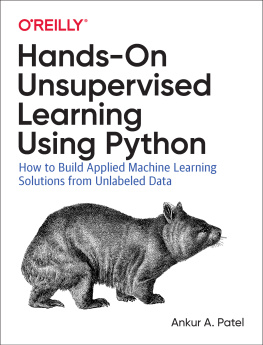MACHINE LEARNING for ALGORITHM TRADING
4 books in 1
Learn the art of Programming with a complete crash course for beginners. Strategies to Master Data Science, Numpy, Keras, Pandas and Arduino like a Pro in 7 days
jason test and mark broker
Copyright 2020 - All rights reserved.
The content contained within this book may not be reproduced, duplicated or transmitted without direct written permission from the author or the publisher.
Under no circumstances will any blame or legal responsibility be held against the publisher, or author, for any damages, reparation, or monetary loss due to the information contained within this book. Either directly or indirectly.
Legal Notice:
This book is copyright protected. This book is only for personal use. You cannot amend, distribute, sell, use, quote or paraphrase any part, or the content within this book, without the consent of the author or publisher.
Disclaimer Notice:
Please note the information contained within this document is for educational and entertainment purposes only. All effort has been executed to present accurate, up to date, and reliable, complete information. No warranties of any kind are declared or implied. Readers acknowledge that the author is not engaging in the rendering of legal, financial, medical or professional advice. The content within this book has been derived from various sources. Please consult a licensed professional before attempting any techniques outlined in this book.
By reading this document, the reader agrees that under no circumstances is the author responsible for any losses, direct or indirect, which are incurred as a result of the use of information contained within this document, including, but not limited to, errors, omissions, or inaccuracies.
TABLE OF CONTENTS
python for beginners
A crash course guide for machine learning and web programming. Learn a computer language in easy steps with coding exercises.
jason test
Introduction
Design patterns are reusable model for solving known and common problems in software architecture.
T hey are best described as templates for working with a specific normal situation. An architect can have a template for designing certain types of door frames, which he fit into many of his project, and a software engineer or software architect must know the templates for solving common programming tasks.
An excellent presentation of the design pattern should include:
Name
Motivating problem
Decision
Effects
Equivalent Problems
If you thought it was a rather vague concept, you would be right. For example, we could say that the following pattern solves all your problems:
This is an example of too abstract thinking. You cannot call it a template because it is not an excellent model to solve any problem, even though it is technically applicable to any of them (including cooking dinner).
On the other hand, you may have solutions that are too specific to be called a template. For example, you may wonder if QuickSort is a template to solve the sorting problem.
This is, of course, a common program problems, and QuickSort is a good solutions for it. However, it can be applieds to any sorting problem with virtually no change.
Once you have this in the library and you can call it, your only real job is to make somehow your object comparable, and you don't have to deal with its entity yourself to change it to fit your specific problem.
Equivalent problems lie somewhere between these concepts. These are different problems that are similar enough that you can apply the same model to them, but are different enough that this model is significantly customized to be applicable in each case.
Patterns that can be applied to these kinds of problems are what we can meaningfully call design patterns.
Why use design patterns?
You are probably familiar with some design patterns through code writing practice. Many good programmers end up gravitating towards them, not even being explicitly trained, or they simply take them from their seniors along the way.
The motivation to create, learn, and use design patterns has many meanings. This is a way to name complex abstract concepts to provide discussion and learning.
They make communication within the team faster because someone can simply use the template name instead of calling the board. They allow you to learn from the experiences of people who were before you, and not to reinvent the wheel, going through the whole crucible of gradually improving practices on your own (and constantly cringing from your old code).
Bad decisions that are usually made up because they seem logical at first glance are often called anti-patterns. For something to be rightly called an anti-pattern, it must be reinvented, and for the same problem, there must be a pattern that solves it better.
Despite the apparent usefulness in this practice, designing patterns are also use ful for learning. They introduce you to many problems that you may not have considered and allow you to think about scenarios with which you may not have had hands-on experience.
They are mandatory for training for all, and they are an excellent learning resources for all aspiring architect and developing who may be at the beginning of their careers and who have no direct experience in dealing with the various problems that the industry provides.
Python Design Patterns
Traditionally, design models have been divided into three main categories: creative, structural, and behavioral . There are other categories, such as architectural patterns or concurrency patterns, but they are beyond the scope of this article.
There are also Python-specific design patterns that are created specifically around problems that the language structure itself provides, or that solve problems in unique ways that are only resolved due to the language structure.
Generating Patterns deal with creating classes or objects. They serve to abstract the specifics of classes, so that we are less dependent on their exact implementation, or that we do not have to deal with complex constructions whenever we need them, or that we provide some special properties of the instantiation. They are very useful for reducing dependency and controlling how the user interacts with our classes.
Structural patterns deal with assembling objects and classes into larger structures while keeping these structures flexible and efficient. They, as a rule, are really useful for improving the readability and maintainability of the code, ensuring the correct separation of functionality, encapsulation, and the presence of effective minimal interfaces between interdependent things.
Behavioral patterns deal with algorithms in general and the distribution of responsibility between interacting objects. For example, they are good practice when you may be tempted to implement a naive solution, such as busy waiting, or load your classes with unnecessary code for one specific purpose, which is not the core of their functionality.
Generative Patterns





